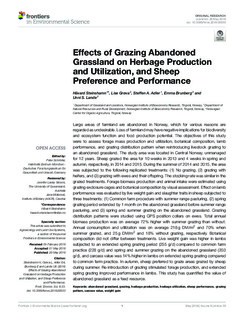| dc.contributor.author | Steinshamn, Håvard | |
| dc.contributor.author | Grøva, Lise | |
| dc.contributor.author | Adler, Steffen | |
| dc.contributor.author | Brunberg, Emma | |
| dc.contributor.author | Lande, Unni Støbet | |
| dc.date.accessioned | 2018-05-31T13:51:51Z | |
| dc.date.available | 2018-05-31T13:51:51Z | |
| dc.date.created | 2018-05-31T11:26:34Z | |
| dc.date.issued | 2018-05-29 | |
| dc.identifier.issn | 2296-665X | |
| dc.identifier.uri | http://hdl.handle.net/11250/2499968 | |
| dc.description.abstract | Large areas of farmland are abandoned in Norway, which for various reasons are regarded as undesirable. Loss of farmlandmay have negative implications for biodiversity and ecosystem function and food production potential. The objectives of this study were to assess forage mass production and utilization, botanical composition, lamb performance, and grazing distribution pattern when reintroducing livestock grazing to an abandoned grassland. The study area was located in Central Norway, unmanaged for 12 years. Sheep grazed the area for 10 weeks in 2013 and 4 weeks in spring and autumn, respectively, in 2014 and 2015. During the summer of 2014 and 2015, the area was subjected to the following replicated treatments: (1) No grazing, (2) grazing with heifers, and (3) grazing with ewes and their offspring. The stocking rate was similar in the grazed treatments. Forage biomass production and animal intake were estimated using grazing exclosure cages and botanical composition by visual assessment. Effect on lamb performance was evaluated by live weight gain and slaughter traits in sheep subjected to three treatments: (1) Common farm procedure with summer range pasturing, (2) spring grazing period extended by 1 month on the abandoned grassland before summer range pasturing, and (3) spring and summer grazing on the abandoned grassland. Grazing distribution patterns were studied using GPS position collars on ewes. Total annual biomass production was on average 72% higher with summer grazing than without. Annual consumption and utilization was on average 218 g DM/m2 and 70% when summer grazed, and 25 g DM/m2 and 18% without grazing, respectively. Botanical composition did not differ between treatments. Live weight gain was higher in lambs subjected to an extended spring grazing period (255 g/d) compared to common farm practice (228 g/d) and spring and summer grazing on the abandoned grassland (203 g/d), and carcass value was 14% higher in lambs on extended spring grazing compared to common farm practice. In autumn, sheep preferred to graze areas grazed by sheep during summer. Re-introduction of grazing stimulated forage production, and extended spring grazing improved performance in lambs. This study has quantified the value of abandoned grassland as a feed resource. | nb_NO |
| dc.description.abstract | Effects of Grazing Abandoned Grassland on Herbage Production and Utilization, and Sheep Preference and Performance | nb_NO |
| dc.language.iso | eng | nb_NO |
| dc.publisher | Frontiers Media S.A | nb_NO |
| dc.relation.uri | https://data.mendeley.com/datasets/gb7822ngty/1 | |
| dc.rights | Navngivelse 4.0 Internasjonal | * |
| dc.rights.uri | http://creativecommons.org/licenses/by/4.0/deed.no | * |
| dc.subject | abandoned grassland | nb_NO |
| dc.subject | grazing | nb_NO |
| dc.subject | herbage production | nb_NO |
| dc.subject | herbage utilization | nb_NO |
| dc.subject | sheep performance | nb_NO |
| dc.subject | grazing pattern | nb_NO |
| dc.subject | carcass value | nb_NO |
| dc.subject | weight gain | nb_NO |
| dc.title | Effects of Grazing Abandoned Grassland on Herbage Production and Utilization, and Sheep Preference and Performance | nb_NO |
| dc.type | Journal article | nb_NO |
| dc.type | Peer reviewed | nb_NO |
| dc.description.version | publishedVersion | nb_NO |
| dc.rights.holder | © 2018 Steinshamn, Grøva, Adler, Brunberg and Lande | nb_NO |
| dc.source.volume | 6 | nb_NO |
| dc.source.journal | Frontiers in Environmental Science | nb_NO |
| dc.identifier.doi | 10.3389/fenvs.2018.00033 | |
| dc.identifier.cristin | 1587985 | |
| dc.relation.project | Regionale forskningsfond Midt-Norge: 227181 | nb_NO |
| cristin.ispublished | true | |
| cristin.fulltext | original | |
| cristin.qualitycode | 1 | |

